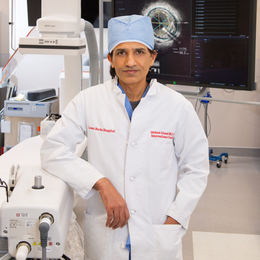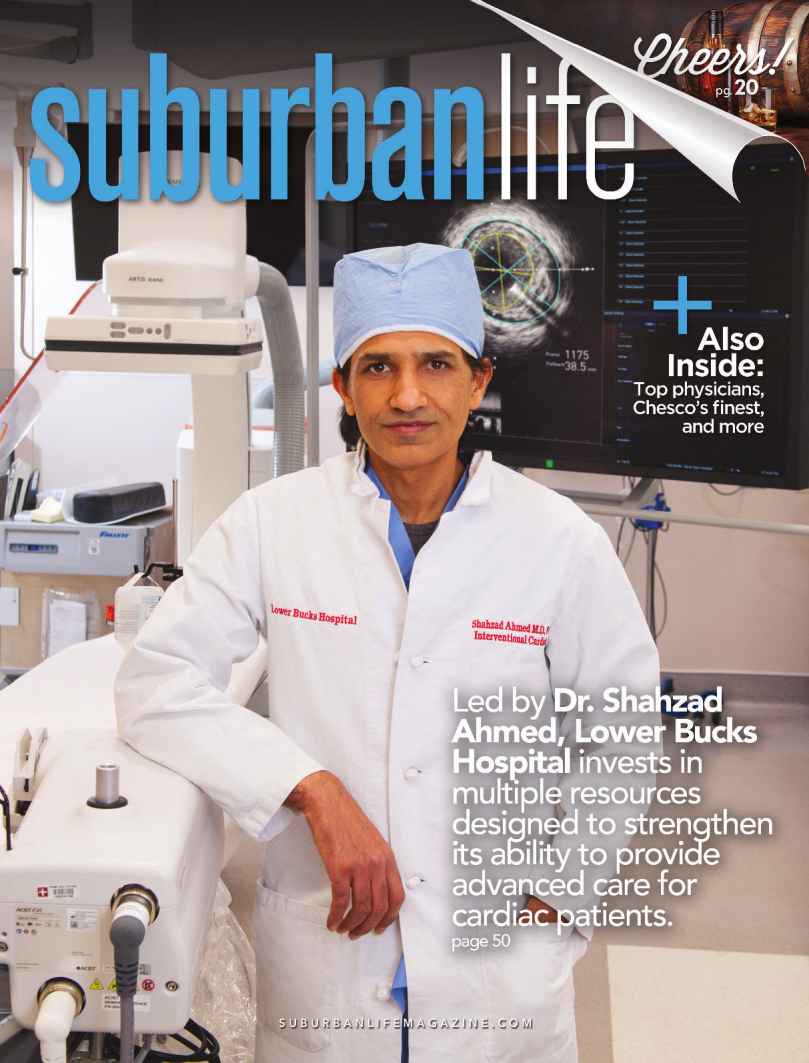
All Heart
Led by Dr. Shahzad Ahmed, Lower Bucks Hospital invests in multiple resources designed to strengthen its ability to provide advanced care for cardiac patients.
Pennsylvanians have a regrettably close relationship with heart disease. With 173.8 deaths per 100,000 residents, the Keystone State has the 19th highest death rate due to heart disease in the United States, according to a Statistica report released in June 2023. Such troublesome statistics may explain why Lower Bucks Hospital, which is in the southeastern corner of the state, has invested so heavily in its ability to preserve and protect patients’ cardiac health.
Perhaps the most visible example of this investment is the opening of a second cardiac catheterization lab to complement the Bristol campus’s original cardiac cath lab, which opened in 1997. At more than 2,100 square feet, the second cardiac cath lab is fully equipped with state-of-the-art technology, including advanced imaging capabilities for more precise visualization to help heart specialists such as Shahzad Ahmed, M.D., FACC, FSCAI, diagnose and treat patients accordingly.
“Our goal has always been to stay at the forefront of cardiac care, and the second cath lab has put us in a better position than ever to do that,” says Dr. Ahmed, the head of interventional cardiology for Lower Bucks Hospital. “In 2019 and 2020, we did less than 400 procedures, and now we’re doing twice that volume. The second lab has also helped us offer more services and work more efficiently to satisfy the demand among people who need care.”
First and foremost, Lower Bucks Hospital’s heart specialists treat patients in need of emergent care, meaning those who present with chest pain, shortness of breath, and other symptoms indicative of a heart attack. Yet the hospital’s capabilities go much, much further.
One example: Percutaneous coronary intervention, also known as stenting, enables patients with narrow or blocked arteries to enjoy a better quality of life for years to come. Another: Diagnostic cardiac catheterization can measure function in heart-failure patients, while subsequent lifestyle modification and medications can help patients manage symptoms and, in the process, decrease the likelihood of rehospitalization. Yet another: The implantation of pacemakers and defibrillators can help patients with abnormal heart rhythms, which could be life-threatening if left untreated.
“We also have the capability to offer solutions for vascular conditions, with procedures to treat blood clots in the legs or lungs, or to address chronic ulcers in the leg or foot caused by low perfusion,” Dr. Ahmed adds. “For people who have a high risk of stroke, new interventions like carotid stenting for the big vessels that go to the brain can help prevent further strokes. By offering those procedures, we can provide immediate relief and also prevent a lot of long-term problems.”
Expanded cardiac care has required an expanded cardiac team—namely, experienced physicians, nurses, radiology technologists, and other members of the clinical staff. Dr. Ahmed says the hospital has effectively doubled the number of vascular technicians staffing the cath labs.
“I’m excited by how much we’ve grown over the past few years,” he adds. “We’re all working as a team to care for our patients. Whether we’re saving lives or improving someone’s quality of life, we’re helping people who come to us very sick and putting them on a path to much better health by the time they leave here.”
Such interventions represent the figurative “first step” in a patient’s journey to better heart health. As for next steps, Dr. Ahmed cites Lower Bucks Hospital’s outpatient program for cardiac rehab.
“That’s when the real work begins,” he says. “Our team is there to help the patient get back on track through medication, lifestyle modifications, and exercise. Cardiac rehab uses methods that have been proven to [address] the problems that brought them here in the first place.”
Lower Bucks Hospital continues to raise its profile as a medical destination in ways aside from direct patient care. The hospital recently received approval from the Accreditation Council for Graduate Medical Education to welcome the next generation of cardiologists to its campus for specialized clinical training. Dr. Ahmed, who will serve as director of the program, is eager to welcome the first cohort of cardiology fellows in July.
About Dr. Ahmed
Dr. Ahmed has advanced specialization in coronary interventions, peripheral arterial and venous disease, and structural heart disease. He is considered an expert in heart and rhythm disorders, including congestive heart failure, coronary artery disease, and vascular disease, as well as sudden death prevention and critical limb ischemia. He also specializes in nuclear stress testing, echocardiograms, and vascular imaging.
Dr. Ahmed has advanced specialization in coronary interventions, peripheral arterial and venous disease, and structural heart disease. He is considered an expert in heart and rhythm disorders, including congestive heart failure, coronary artery disease, and vascular disease, as well as sudden death prevention and critical limb ischemia. He also specializes in nuclear stress testing, echocardiograms, and vascular imaging.
“Heart disease is the No. 1 killer of men and women in the United States,” he says. “I’ve always been interested in medicine, but cardiology was the specialty that most appealed to me because there are so many issues that can affect the heart, and every day you have the opportunity to save someone’s life.”
Dr. Ahmed began his medical education at Allama Iqbal Medical College in Lahore, Pakistan, and continued his training in Philadelphia through the Educational Commission for Foreign Medical Graduates. He did his internship and internal medicine residency at Drexel University at Hahnemann University Hospital. He also completed a fellowship in cardiovascular medicine and interventional cardiology through Drexel.
He has since become board certified in echocardiography, vascular ultrasound, nuclear cardiology, interventional cardiology, cardiovascular medicine, and internal medicine. In addition, he is a fellow of both the American College of Cardiology and the Society for Cardiovascular Angiography and Interventions.
Lower Bucks Hospital
501 Bath Road
Bristol, PA 19007
(215) 785-5100
www.lowerbuckshosp.com
501 Bath Road
Bristol, PA 19007
(215) 785-5100
www.lowerbuckshosp.com
Photo by Alison Dunlap
Published (and copyrighted) in Suburban Life magazine, February 2024.



